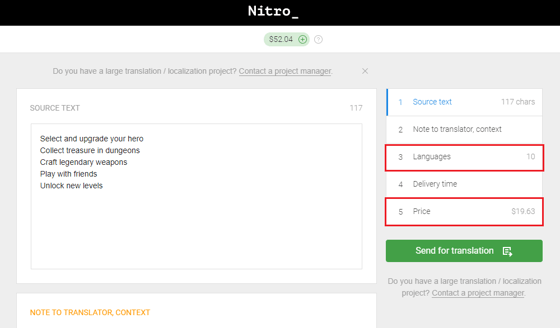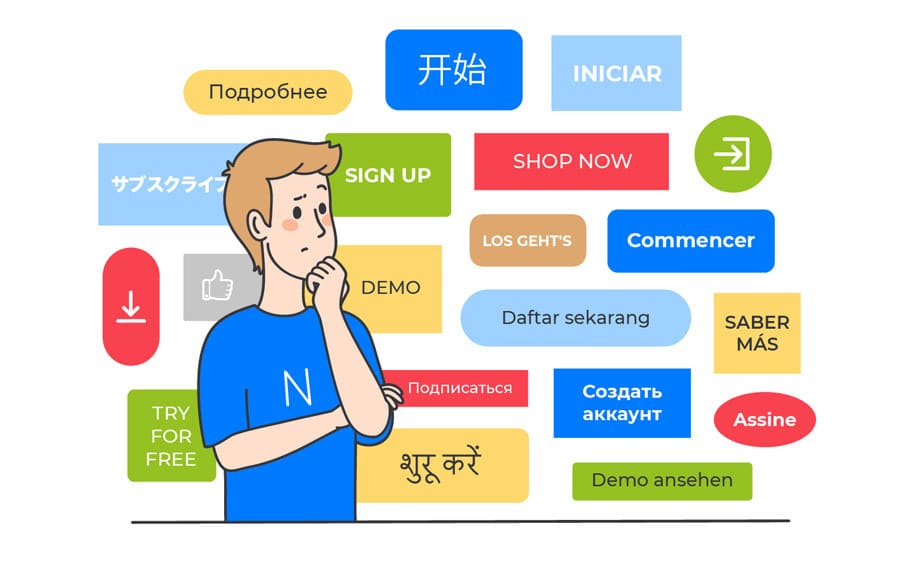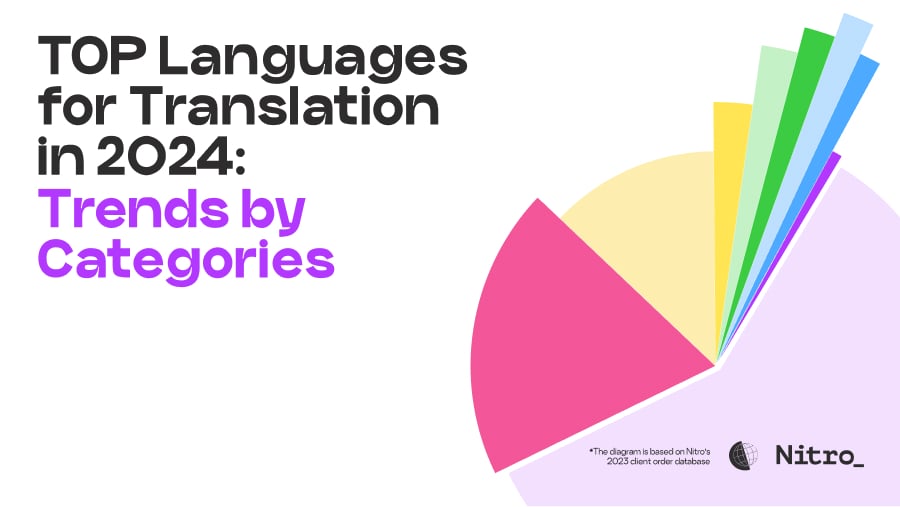Mobile game and app companies are continuously searching for ways to expand their audience base. While it’s common knowledge that localizing your app store page is a must for boosting downloads, localization of your app content will have a significant impact on retention.
Drawing on our 18-years of experience in app localization, we would like to share our tips and best practices which should be useful for those who are experienced in app & game localization, as well as for those who have yet to develop a solid localization strategy.
Here are the topics we will cover:
- Most profitable languages for app & game localization
- Typical localization mistakes
- What tools to choose for a smarter localization process
- Examples of how mobile app localization boosts its success
Which localization languages are the most profitable?
First off, we should point out that it depends on the type of game/app you’re developing. Put simply, certain genres of games and apps are more popular in certain regions, and this definitely requires some competitor research.
As a rule of thumb, companies choose one of the following strategies:
- go for Tier 1 countries
- expand this range of regions and try less popular regions with less competition.
The 2nd approach was very successful for one of our clients, Wachanga — an ecosystem of mobile apps. They have translated their apps into over 50 languages and this brought fruitful results: they generated a significant amount of revenue from less popular regions which are not as competitive as the US, UK, or Germany.
On the graph below you can see some stats from the Alconost data. These are the most popular languages for mobile apps and games localization. The list of these top 10 languages has been more or less consistent, including languages like German, Portuguese, French, Spanish, Italian, Polish, Russian, and the key Asian languages — Chinese, Japanese, and Korean.

Languages that are gaining traction include Turkish and Arabic, along with the APAC languages such as Thai, Vietnamese, and Malay. Sometimes localization into these languages can bring you more profit than you would expect.
You can learn more about languages and regions in our article Top 10 languages for game localization.
Volunteer translators vs. freelancers vs. localization companies — who should we choose?
When mobile app companies try to find a localization solution that is time- and cost-effective, they usually end up choosing between volunteer translators, freelance translators, and localization companies.
We haven’t included machine translation in this list, as machine translation is not reliable enough to produce a quality translation for the end-user. Sometimes professional translators even refuse to edit machine translated text because it may be incomprehensible, and also because it’s easier to translate the text from scratch rather than rework and edit machine translations. In most cases, using machine translations is risky and can’t be recommended.

Volunteer translators (including community translations). An obvious benefit is the cost. You can get these translations for free/at a low price, but that comes with its own challenges:
- You may have to wait for a long time until the translation is finished (there are no set in stone deadlines).
- There may be many mistakes, as volunteer translators are usually people with little or even no experience in localization, let alone game localization specifically. They can be people who just want to gain experience and start a career in the localization industry using your project as a way to get started, which is good for them, but may not be for you.
- Complicated management: you have to contact each translator every time you have new content for translation, the deadline is approaching, you need to pay them, etc. That’s a lot of manual work. Additionally, using a large Google spreadsheet to store the translations increases the chances for accidental mistakes.
In this article, we looked into the localization process of Goat Simulator, a well-known game by Coffee Stain Studios, who used community translation for their game, but faced some challenges along the way.
It is better to use localization platforms which we’ll discuss below. Working on localization platforms definitely makes life easier, but generally it’s quite a hassle to work with volunteer translators or community translators.
Freelance translators are better in terms of being professional, experienced translators — and usually native speakers. Their translation services are more or less affordable, but again that involves a lot of manual work: just imagine all the back-and-forth communication already described in the part about volunteer translators.
This process goes more smoothly if you use localization platforms, but again, you bear a lot of responsibility and micromanagement, which is a headache. There may be problems with consistency, if your localization process is not fine-tuned, if you don’t use glossaries, and so on.
Localization companies involve less management and manual work, guarantee consistency and use professional tools.
Many companies turn to localization agencies like Alconost, because they want to avoid all the micromanagement and headaches, and they don’t want to have to build the localization process from scratch.
Localization companies bear the responsibility for the quality of the translations, for the management of translators, and essentially free you of the burden of manual work. You just need to send your files to the project manager and get them back with the translations. Every now and then, the project manager may come to you with questions from the translators, but it isn’t time-consuming and is usually done conveniently through a localization platform.
No matter whether you work with freelance translators or localization companies, it is important that translators you turn to are native speakers of the target language: that is, if you need a translation from English to Japanese, the translator should be a native speaker of Japanese and have a near-native level of fluency of English.
It does happen that some companies hire non-native translators, and this may result in translations that don’t flow naturally. The best practice is to use native speakers exclusively.
Localization tools that help reduce manual work
We’ve already mentioned localization platforms, but what are they? Some of the most popular platforms include Crowdin, Lokalise, SmartCat, POEditor, Phrase, Transifex, and so on. There are many more to choose from.
The advantages of using localization platforms:
- Support for a wide variety of file formats (Crowdin supports 70+ file formats)
- Easy management and tracking of issues
- Glossary to help keep the translation consistent
- Use of TMs (translation memories) to reduce costs
You can also set things up so that new content is uploaded and retrieved automatically through an API. With localization platforms, it’s easy to manage this process, check and solve any issues, and track the progress.
It’s nice to know that translators basically don’t have a chance to mess up the code, because when your file is uploaded on a localization platform, the content is separated from the code, so translators only see the text for translation.
There are also automatic QA systems, so if there are figures or links in the source text and a translator accidentally removes them, the system will point out that the original figure/link is missing.
Lightweight self-service platform Nitro for short and quick translations
Sometimes you have translations that are relatively short, and you probably don’t feel like contacting a project manager for a minor mobile app update or a small feature that you need translated into 20 languages.
Besides, if you turn to a localization company with a small translation task like this, you’re likely to be charged a minimum order fee for each language, so it may get pricey.
For cases like this, you may want to use our human translation platform Nitro which employs a process that differs from standard localization platforms. Nitro is a self-service platform which means you don’t need a project manager to send the text for translation and get it back. Take a quick look at Nitro in action:
You just login into the platform, paste your text, choose the required languages, pay for it online — and you receive your translations within 24 hours. This is one of the key benefits of Nitro: translations that are not only done by native speakers, but also get completed quickly.
There are over 60 languages available on the platform, and it’s very easy and fast to place an order. There is no back-and-forth communication, and you can even provide context for your order as shown in the screenshot below.

Nitro is a very handy platform if you need to translate something really quickly and the text is relatively short — like app store descriptions.

Typical localization mistakes you want to avoid
Now let’s take a look at some typical localization mistakes you may encounter — these issues crop up for experienced and inexperienced users of localization. We are all in the same boat!
Interfaces that are not scalable
Length of text strings frequently becomes a problem, especially in mobile apps and games. English is the most compact of European languages, so when English text is translated into Spanish/German/Russian/French, the words may get 20-25% longer than English words, and no longer fit into the interface.
To avoid this problem, you can make the interfaces scalable. In the screenshot below, you can see how much longer the Russian words are. This particular game was translated from Chinese into English and other languages, and you can clearly see how much shorter and more compact the original Chinese text is.

One more thing you can do is to run a so-called pseudo-localization, that is machine translation into one of your target languages, such as German, which is a language with very long words. By creating the machine translation into German, you can get an idea of how long the strings may be and what your scalable interfaces should look like.
Tricky fonts for RTL (right-to-left) languages and Asian fonts
RTL languages are languages such as Hebrew and Arabic. As the name suggests, the words are written from right to left, which may pose challenges with the interface layout. These languages also require special fonts, adding an extra layer of complications.
Here is what may happen when the wrong font is used. The developers accidentally applied the wrong font, and some Japanese characters got replaced with Chinese characters (highlighted in the screenshot). As a result, the app was rejected by the Google Play team.

This screenshot was provided by one of our clients when they complained about the translation being rejected. Fortunately, our translators have extensive experience in mobile app localization, and they immediately suspected that the problem was with the wrong kind of font, which did prove to be the case.
So this is something to pay attention to, otherwise the characters may be displayed incorrectly.
Localization includes adaptation
Not everyone realizes that localization is not just translation. Localization also includes adaptation of some things we don’t often think about:
- dates (compare the US format 03/11/2022 vs. 11/03/2022 in Europe)
- time (5:30 pm in the US vs. 17:30 in Europe)
- measurements of weight and distance (think miles vs. kilometers, pounds vs. kilograms)
- and even the way discounts work!
Sometimes clients order a translation into Chinese that might contain a phrase like 20% discount, and they believe something is wrong with the translation because it says 8折 instead of 20%. “These numbers look wrong! There must be a problem!”
However, in Chinese discounts have a different logic behind them:
8折 means “you pay 80% of the original price” — that is, 20% off. An accurate localization of a tricky translation.
Getting the context wrong
Context is probably the biggest problem for developers who are just getting started with localization. People think that if you give a list of words and phrases to the translator, it is enough, because translators speak the language.
However, this is not how it works. Imagine all you got is a list of words and no explanations whatsoever. Let’s take the word “block” for example (to block? An apartment block? A toy block? A street block?). With so many options to choose from, and without an explanatory comment or a screenshot of this item, the translator will have to take a wild guess.
Sometimes it’s important to know if the character is male or female, as this influences the form the word takes in languages such as French, Spanish, and Portuguese.
In the example below, the context was “Day 0/30”, but the client figured they didn’t need to translate the 0/30 part, as it is the same in other languages. So the word day was translated out of context and the client simply inserted it into the text.
The problem here is the word position in Japanese and Korean, which is different from English. The translation was rejected by the Google Play team just because of this mistake. Fortunately the mistake could be quickly corrected, and the update was finally approved.

App marketing: ASO & UA activities at scale
UA campaigns and working with ASO are key elements of promoting your mobile app. We have a great article with tips for multilingual ASO, but for now let’s have a quick recap of what ASO is.
Multilingual ASO
ASO (App Store Optimization) includes working with titles, subtitles, keywords, descriptions, screenshots, icons, and videos. With a global launch, these should all be localized.
Keywords are important and require specialized research with the help of ASO tools as it’s not enough to just translate them from English. There are many ASO tools now like AppRadar, ASOdesk, Appfollow, and so on.
Description: some developers only translate the first couple of sentences if they are on a tight budget.
Even more important than translating the app store descriptions is translating the text on the screenshots. This is simple, cheap, and can be done quickly through an online translation platform like Nitro as it provides a straight-forward process for order placement and quick turnaround.


Ads in other languages
With an eye on UA activities, we’d like to give you an example of our client Narcade, a Turkish mobile game development company. They had a promo video of their mobile game in English, and they simply translated the captions in the video into Japanese through Nitro.
Here is what they said about that campaign:
“The result was incredible. The Japanese creative got a 70% CTR (click ratio), while the English one got a 30% CTR, and we were able to get many more installs thanks to the creative in the Japanese language.”

Some game publishers who run lots of Google ads in other languages, also use Nitro to optimize their workflow. As a publisher, they launch multiple campaigns every week, so it would be time-consuming for them to place these orders on Nitro every time they had a new Google ads campaign. They use Nitro API so that they can send these orders to Nitro and get the translations automatically without logging into the platform. A nice feature is that they can also set a character limit to fit the Google ads requirements.
For Google ads text, there tends to be just one string that needs to be translated into 10 languages. Getting all of this work done manually would be a huge hassle as there is an impressive amount of these ads. Thanks to the Nitro API, the majority of this work can be automated thereby saving you time and effort.
We hope these tips will help you in your global strategy, as well as help optimize your marketing localization activities!
Learn more about marketing localization for mobile apps!



















